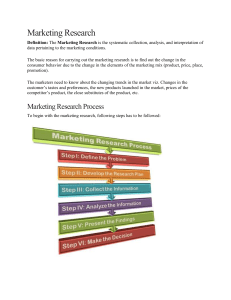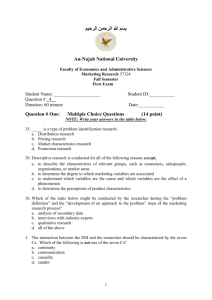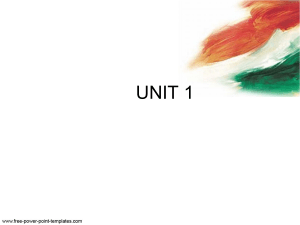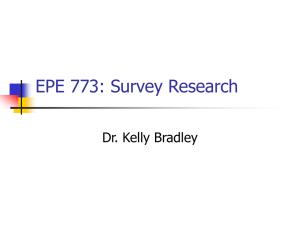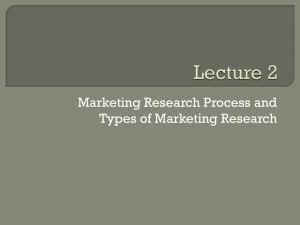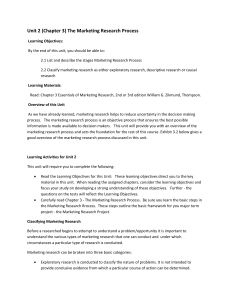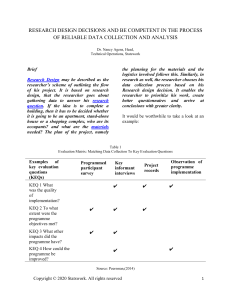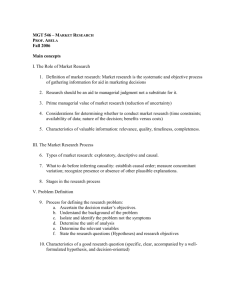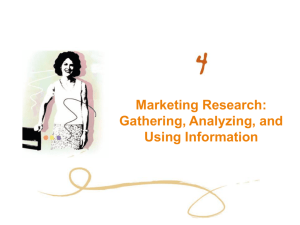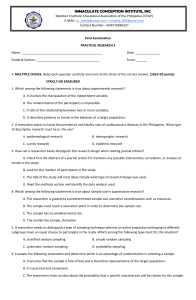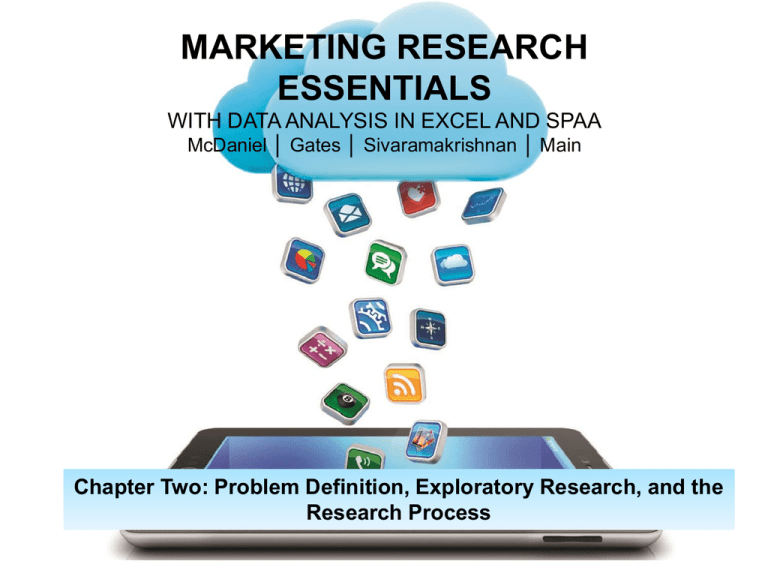
MARKETING RESEARCH
ESSENTIALS
WITH DATA ANALYSIS IN EXCEL AND SPAA
McDaniel │ Gates │ Sivaramakrishnan │ Main
Chapter Two: Problem Definition, Exploratory Research, and the
Research Process
LEARNING OBJECTIVES
Chapter Two: Problem Definition, Exploratory Research, and the Research Process
• Understand the problem definition process
• Describe the steps involved in the marketing research
process
• Understand the components of the research request
• Describe the three basic research methods
• Learn how the marketing research process is initiated
The Problem Definition Process
What is the problem
or opportunity?
Any suspect motives?
Complete
situational analysis
Find the root
of the problem
Mgt. support is key
Have you researched
other research?
Are the objectives
doable / realistic?
Ensure information needs
are clearly stated
Recognize the problem or opportunity
Find out why the information is sought
Understand the decision-making environment
Use the symptoms to help clarify the problem
Translate mgt. problem to marketing research problem
Determine whether the information already exists
Determine whether the question can be answered
State the research objective
Recognize the Problem or Opportunity
1. This is the first step
2. Need to be anticipate / be responsive
to changes in the external environment
3. Marketing research can define
problems and opportunities
Why is the Information Needed?
1. Important to understand this
so time/money not wasted or
incorrect research completed
2. What will the information be
used for?
3. What information is most
important?
The Decision-Making Environment
1. Situation Analysis
2. Exploratory Research
• Pilot Studies
• Experience Surveys Analysis
• Secondary Data Analysis
• Case Analysis
• Focus Groups
• Intranets
Use Symptoms to Clarify Problem
1. What are the symptoms of the problem?
2. What is the deeper problem?
• Iceberg Principle
From Management to Research Problem
1.Management Decision Problem – action
oriented, broader
2.Marketing Research Problem – what
information is needed to solve the
management problem
3.Marketing Research Objective – goal
statement
Does the Information Exist?
1. Dig through company information to find out
2. If it exists, time and money are saved
3. Avoid the “Nice-to-Know Syndrome” –
research must be actionable
Can The Question be Answered?
1. Yes, if the type of information exists or can be
obtained
2. If you are looking for something quite new, it’s risky
State the Research Objectives
1. Stated in terms of precise information needed to
address the problem or opportunity
2. Must be well formulated as they are the project’s
roadmap
3. Must be specific, unambiguous, and approved by
the manager
4. Not a task list, but what the study will achieve
The Marketing Research Process
Creating the Research Design
Research Design – the plan to be followed to answer the
marketing research objectives
Descriptive Studies – answer who, what, where, when and
how; helps define and understand relationships between
variables in the problem
• To gain better understanding of the market
• Determine trends, brand loyalty, customer profiles
Creating the Research Design
Causal Research
• Confirms theories
• Identifies cause and effect
• Shows clear relationships between independent
and dependent variables
Creating the Research Design
Dependent Variable
•
•
Concept expected to be explained or influenced by
the independent variable
Change in the dependent variable occurs by
manipulating independent variables
Independent Variable:
•
Concept over which the researcher has control and
which is hypothesized to cause or influence the
dependent variable
• Concomitant Variation
• Temporal Sequence
• Spurious Association
Choosing the Research Method
Survey Research:
Interviewer
interacts with
respondents to
obtain facts,
opinions, and
attitudes
Observation
Research:
Descriptive
research that
monitors
respondents’
actions
Experiments:
Measures causality, in
which the researcher
changes one or more
variables and observes
the effect of the changes
on another variable
Selecting a Sampling Procedure
Probability Sampling:
• Sample a subset of the population
• Assumed to be a representative cross-section
• Every element in the population has a known
chance of being selected
Non-probability Sampling:
• A subset of the population
• Chances of selection for the various elements in the
population are unknown
• Usually based on convenience
Complete the Process…
• Collect the Data
• Analyze the Data
• Write and Present Report
• Follow Up with Client
Managing the Research Process
The Research Request
•
•
Describes potential research project
Includes benefits and estimated costs
Request for Proposal
• Soliciting suppliers to submit formal proposal
• Company provides why study is needed, research
objectives, methodology, and time frame
• Suppliers provide costs, their experience, and references
The Marketing Research Proposal
I.
II.
III.
IV.
V.
VI.
VII.
VIII.
IX.
X.
Title Page
Statement of Research Objectives
Study Design
Areas of Questioning
Data Analysis
Personnel Involved
Specifications and Assumptions
Services
Cost
Timing
What Do Clients Want?
Clients want a marketing research supplier who:
1.
2.
3.
4.
5.
6.
7.
8.
9.
10.
Maintains client confidentiality
Is honest
Is Punctual
Is flexible
Delivers against project specifications
Provides high-quality output
Is responsive to the client’s needs
Has high quality-control standards
Is customer-oriented in client interactions
Keeps the client informed throughout the project
Will the Research Be Used?
Determinants of whether research is used or not:
1.
2.
3.
4.
5.
6.
7.
8.
Researcher communicates effectively
Quality data is generated
Costs are controlled
Information is delivered on time
Conforms to prior expectations
Clear presentation
Political acceptability within company
Lack of challenge to the status quo
Copyright
Copyright © 2014 John Wiley & Sons Canada, Ltd. All rights
reserved. Reproduction or translation of this work beyond
that permitted by Access Copyright (the Canadian copyright
licensing agency) is unlawful. Requests for further
information should be addressed to the Permissions
Department, John Wiley & Sons Canada, Ltd. The purchaser
may make back-up copies for his or her own use only and
not for distribution or resale. The author and the publisher
assume no responsibility for errors, omissions, or damages
caused by the use of these files or programs or from the use
of the information contained herein.

